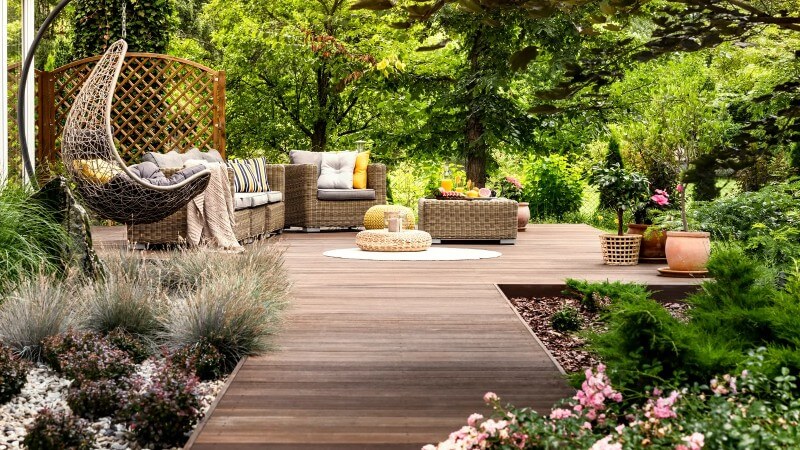The actualization of a visually-pleasing landscape and one that can be termed, “perfect” is subject to following certain principles, such as proportion, order and consistency.
In this article, we introduce you to some of the principles of landscape designing. These are the factors that do not only make the landscape attractive, but also practical.
What is Landscape Design?
It is simply the process of developing a practical and user-centric outdoor space. The designers need to pay close attention to the availability of spaces, the needed contrasts, the need to unify the process and repeat where necessary.
When all these factors are put in place, it is safe to say that a perfect landscape has been developed.
Core Principles for Landscape Design
Order, repetition, consistency and proportion are some of the basic perfect landscape design principles. Below, we go in-depth into discussing how they all come together to form a bigger “picture.”
1. Proportion
It has to do with the size of an element or object as it relates to another. Proportion as a landscape design principle gives the following ideas:
- How the various objects will appear.
- Proportion helps the designer understand how the different elements or objects can come together to work as a whole.
Tips on Getting the Right Proportion
These are tips on how to get the right proportion:
- The size of the objects (such as ornaments, plant materials and garden structures) should be relative to the size of the human body (human scale).
- The proportion of the hardscape should be similar to the house. For example, aim to have a mini-sized patio that offers easy access and comfortability for the users.
- Opt for an implied enclosure, such as a tree branch or a mini ceiling. It helps to create a psychological effect of closure and security for the users beneath it.
2. Order
The principle of Order in landscape designing has to do with the following:
- Forming a balance or equilibrium on the left and right-hand sides of the landscape.
- It refers to the spatial organization or layout of the landscape.
The core considerations for balance or order in the landscape include:
- Maintaining an equal visual weight and attraction.
- Leveraging the combination of texture, form, size and color to maintain the landscape’s balance.
Types of Orders in Landscape Design
You will find a variety of groupings for the order or balance of the landscape. These are:
-
Symmetrical Balance
Also called symmetrical order; it has to do with the placement of the same types of objects on either side. The concept also includes:
- Making sure both sides of the landscape are identical or the same.
- Actualizing a combination of dignity, stability and stateliness via this method.
- Forming mirror images through the integration of the same hardscapes and objects on both sides of the landscape.
-
Asymmetrical Order
This type of landscape order or balance aims to achieve an effect composition via the balancing or using of equal visual weight of nonequivalent forms.
It also includes:
- Balancing the several elements and features that have a similar visual weight, in terms of their colors, textures and forms.
- Differentiating the balance or order from left to right and vice-versa.
- Asymmetrical landscape order also gives room for movement and curiosity.
3. Repetition
This is a landscape design principle that encourages the reuse of familiar sequences, patters and species to avoid confusion.
The landscape principle of repetition also covers:
- Creating a pattern and reusing the same elements to breed a harmonious feel in the landscape.
- Reusing the elements to build unity or semblance of the order.
Tips to Repeat a Landscape Design
Follow these tips to get a repeatable landscape design:
- Use alternation, which encourages a minor or minimal change in the sequence, on a regular basis. It also helps to create subtle repetition.
- You can also use subtle repetition, which has to do with the non-patterned method. In this case, it deals with the repeated use of the following – same color, form, and texture throughout the landscape.
- There is also gradation, which deals with the gradual or systematic change in the element’s characteristics or properties.
Also Read:
- What is Rendering in Interior Design?
- Architectural Symbolism: Decoding Hidden Meanings in Buildings
4. Unity
As the name signifies, unity as a landscape design principle has to do with the “unification” or “oneness” of the design.
Thus, the unification helps to create a landscape where all the different elements or objects are optimized to work as one part.
Unity can also be called harmony. It includes:
- The effective use of unity of three, dominance, interconnection, unity by simplicity with the aim of arranging the forms, textures and colors.
- Using a design style or design theme to create the perfect landscape harmony.
5. Paths
The creation of pathways or paths for short is an effective landscape designing principle that helps prevent obstructions, while improving the practicability of the use.
Here are some of the ways to implement these:
- Create walkways a bit away from the sitting area or area. That way, dirt and other debris wouldn’t be overly attracted towards the area.
- Consider creating the paths or walkways to accommodate at least two people at a go.
6. Color
The choice of color can make or mar the beauty of the landscape design. Hence, the designer must be strategic when working with the physical or visual representation of the project. The best landscape designing result must colorful.
Here are some options worth considering:
- Go for the warm color scheme to make objects closer, creation stimulating, cheerful and high-scale effects. Examples of such colors are orange and red.
- If you opt for cool colors, you would be able to create different perspectives, while making the objects seem a bit farther than they are. Examples of such colors are green and blue.
Note: the overall submission is that the choice of color helps to evoke the right emotions, and to create the desired mood in the landscape.
Final Thoughts: Landscape Designs are Powered by Principles
The different principles discussed in this article come together to improve the aesthetics of a landscape, while helping evoke the require emotional connection, and improve the user’s comfort.
Hire a professional landscape designer with an eye for details to get the job done.
Would you like to hire a US-based professional architect for your pickleball court design and other architectural services, contact me today to share your expectations with me. Check out my Upwork profile to see reviews about my work.
Image credit: GettyImages










